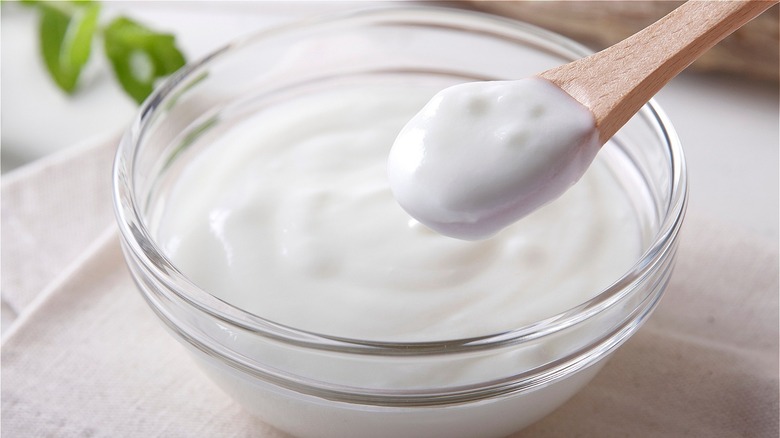Think Twice Before Substituting Yogurt For Greek Yogurt In A Recipe
When it comes to cooking, there are a lot of easy ingredient swaps that make life easier. Maybe you don't have a particular item on hand or need to use something else up first before it goes bad. Maybe you just want to make a certain dish healthier. For example, there are a few simple ingredient swaps that can help make creamed spinach better for you. Maybe it's cocktail hour at home — try swapping in cognac for vodka in your espresso martini.
Half and half can easily be swapped out for coconut milk to make something dairy-free, beef broth can be substituted for veggie broth to make a dish vegetarian, or you can even add 1 tablespoon of vinegar to 1 cup of milk if you don't have buttermilk on hand. There are certain swaps, however, that aren't simple. For example, many gluten-free flours behave differently than regular flour and require recipe adjustments. And swapping out a dairy product for a non-dairy alternative might change the flavor profile of a dish.
One dairy product that has seen long-term popularity in both cooking and baking is plain yogurt. In recent years, Greek yogurt has become increasingly available in stores. You might think they are one and the same, but you'll want to think twice before substituting regular yogurt for Greek yogurt in a recipe.
Swapping yogurt for Greek yogurt can affect consistency
The reason you often cannot swap Greek yogurt for regular yogurt comes down to consistency. At their core, both yogurts are made basically the same way from the same ingredients. The difference comes from how each is finished. Regular yogurt is cultured — and that's it. Greek yogurt is cultured and then strained, allowing the whey to drain off and resulting in a thicker texture.
If a recipe specifically calls for Greek yogurt and you use regular yogurt instead, there's a risk that the end result will be far wetter than your original intent. This is especially true when it comes to baking, which requires precise measurements in order to achieve the correct final product. For example, using 1 cup of regular yogurt instead of 1 cup of Greek yogurt in a recipe for a pound cake could result in a wet, underbaked cake.
Don't despair if you only have one type of yogurt on hand: Regular yogurt can be spooned into a strainer lined with cheesecloth and allowed to drain for a bit to obtain the texture of Greek yogurt. And Greek yogurt can be thinned with liquids like water, broth, or olive oil before being used to coat meats as part of a marinade, for example. Just remember, it's not that the two can't be swapped — it's all in how you swap them. With a little extra care, you'll find your regular yogurt and Greek yogurt can be interchangeable.

